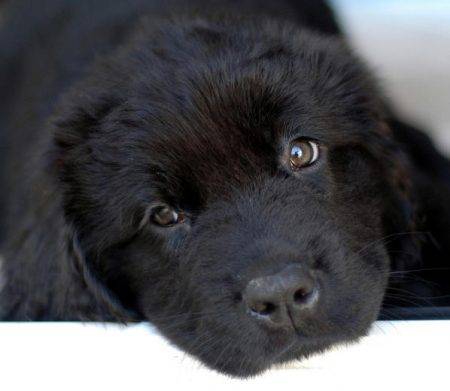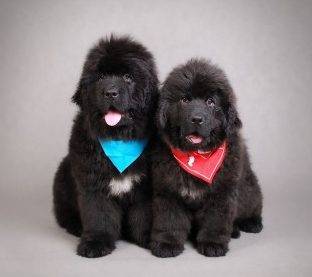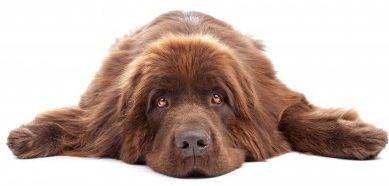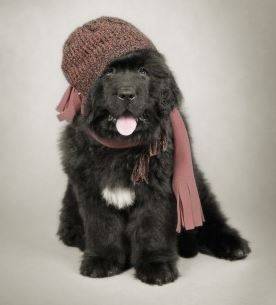Newfoundland Dog Breed Information Guide
 Newfoundland dog breed information profile includes history, appearance, size, temperament, lifespan, health, training of Newfoundland dogs and puppies.
Newfoundland dog breed information profile includes history, appearance, size, temperament, lifespan, health, training of Newfoundland dogs and puppies.
Thinking about adding a Newfoundland dog or puppy to your family?
Check out our Newfoundland Adoption Listings and Newfoundland Breeders directory.
All About Newfoundland Dogs and Puppies
 The Newfoundland Dog is one of the world’s most recognizable breeds. If you have ever visited his namesake’s Canadian province, then you will have a better understanding of the Newfie dog’s attributes. The province of Newfoundland is rugged and sea-loving and its people are warm and gentle, with patience for those in need. Indeed, this is precisely the temperament of the Newfoundland Dog.
The Newfoundland Dog is one of the world’s most recognizable breeds. If you have ever visited his namesake’s Canadian province, then you will have a better understanding of the Newfie dog’s attributes. The province of Newfoundland is rugged and sea-loving and its people are warm and gentle, with patience for those in need. Indeed, this is precisely the temperament of the Newfoundland Dog.
Early on, the Newfoundland Dog was a tireless worker. His enormous strength and unbridled courage made him a lifesaving resource on land and at sea. Today, the Newfoundland’s duties as a lifesaving dog are not totally retired, but generally, he is a beloved pet. Although, some Newfoundland Dogs have the rather posh job of a provincial mascot, touring far and wide representing his home. And, while on tour, the Newfoundland Dog is the star attraction to all he meets.
Newfoundland Dog History
 As the name implies, the Newfoundland Dog was developed in Newfoundland, Canada. There can be little doubt that early in its history, the Newfoundland was influenced by the Tibetan Mastiff even though there is no official record of Tibetan Mastiffs ever having come to the region. Similarly, it is widely believed that English Retrievers and even Huskies may have influenced the genetic pool of this breed. The precise ingredients notwithstanding, the Newfoundland became a massive and rugged breed, widely known for its love of all things aquatic and for its unmatched power.
As the name implies, the Newfoundland Dog was developed in Newfoundland, Canada. There can be little doubt that early in its history, the Newfoundland was influenced by the Tibetan Mastiff even though there is no official record of Tibetan Mastiffs ever having come to the region. Similarly, it is widely believed that English Retrievers and even Huskies may have influenced the genetic pool of this breed. The precise ingredients notwithstanding, the Newfoundland became a massive and rugged breed, widely known for its love of all things aquatic and for its unmatched power.
By the late 1700’s the Newfoundland was well established as a worker dog, hauling from the ocean nets filled with fish and fishermen from a watery grave. The Newfoundland’s tremendous strength coupled with his curiously webbed feet afforded him Phelps-like speed and amazing agility in a raging sea. On land, this powerful dog found work as a draft dog, pulling sleighs brimming with timber, fish and coal over snow covered terrain.
It was around that time that European visitors gleaned show potential from this majestic breed. Many Newfoundlands were swept off to a life of glitz and glamour in the ring. This, coupled with peculiar laws regulating ownership; no one owner could own two Newfoundland Dogs, caused the Newfoundland’s numbers to decline dramatically. Soon, American Newfoundland fanciers had to look to England for this breed. By the end of WWII, the Newfoundland was well established in Europe and America.
Newfoundland Dog Appearance
 The Newfoundland is one of the largest breeds of dog. Commonly, the Newfoundland weighs in at a hefty 140 pounds, but potential owners take note that many Newfoundlands weigh 200 pounds and the heaviest recorded weight is a stunning 260 pounds. When measured from nose to tail this record-setting giant measured six feet in length.
The Newfoundland is one of the largest breeds of dog. Commonly, the Newfoundland weighs in at a hefty 140 pounds, but potential owners take note that many Newfoundlands weigh 200 pounds and the heaviest recorded weight is a stunning 260 pounds. When measured from nose to tail this record-setting giant measured six feet in length.
Usually, Newfoundland Dogs are solid black in colour. There can be wisps of white or gray on his chin, chest or feet. Less common but equally striking is the brown or gray variety of Newfoundland. A forth coloration is white with black markings. This variation is called the Landseer after the well known Victorian painter Edwin Henry Landseer.
The Newfoundland’s coat is thick and water resistant (baths be-damned!). The undercoat is dense with a coarse, slightly wavy outer coat. The Newfoundland’s head is broad with relatively small eyes and ears. The Newfoundland has droopy eyes and jowls with the latter allowing breathing while swimming in stormy seas. But make no mistake, these functional jowls have an unpleasant by-product in the form of drool. And the Newfoundland can drool-a-plenty.
Newfoundland Dog Temperament
The Newfoundland is affectionately known as the Gentle Giant. He is the kindest and gentlest of all dog breeds and is unwaveringly patient with children. Newfoundland owners report that he is mild with guests, kind and loyal toward his owners and intelligent enough to measure danger against his family and to act accordingly.
The expression of the Newfoundland is one of peaceful benevolence. He is a quiet dog and will seldom bark, choosing instead to put his massive girth between his owner and danger. When he does bark, it is deep and loud but no friendly guest will ever be greeted in an aggressive manner. Indeed, the Newfoundland is as sweet as he is lovable.
Newfoundland Dog Exercise Info
The Newfoundland does not have demanding exercise needs and prefers short, dignified walks or joyful romps in a fenced yard. Swims in cold water pulling nets or the like truly suits his fancy, but this can be a challenge to organize. The Newfoundland does especially well in cold weather and he will love to play in the snow. He is not however, well suited to hot weather so be cautious when walking your Newfoundland during summer months.
Newfoundland Dog Grooming Info
The Newfoundland dog’s sheer size and thick coat means that his grooming is demanding. He will need daily brushing to prevent matting and to control the shedding hair. In spring the shed is monumental so be prepared to sweep and vacuum daily. In summer, your Newfoundland will relish long, cool swims.
While this activity can rejuvenate your Newf, the subsequent brushing can exhaust the owner. Winter is another challenge, especially if you live in a region that has the misfortune of snow. Your Newfoundland will play in it gleefully until he cocooned, mummy-like in snow. First he will need melting, then drying, then brushing.
And then there’s the drool’..
Newfoundland Dog Training Info
Mercifully, training your Newfoundland dog will be relatively easy. You will not need to physically move or direct your Newf as he is always eager to please. As is the case for all dogs, begin crate-training your Newfoundland puppy at an early age. The inherently gentle Newfoundland will need to learn basic commands of heel, come and stay, but beyond these, his behavior is appropriately self-managed.
Newfoundland Dog Health Info
Common health concerns for your Newfoundland include; SAS, cytinuria, elbow dysphasia, CHD, gastric torsion. Also of note are Osteochondritis Dissecans, entropion, ectropionm vWD, cataracts, cruciate ligament rupture and epilepsy.
Is a Newfoundland Dog or Puppy The Right Choice For You?
The Newfoundland Dog is both gentle and majestic. He will warm your heart (and feet) and protect all who dwell in his home. Although any person alive would fall immediately in love with the Newfoundland’s sweet temperament, he is not well suited for all homes. Simply put, the Newfoundland Dog needs space, both inside and out. So, if you are a city dweller in a chic micro-condo, forget it.
On the other hand, if you are a suburbanite with a large fenced yard and a sizable home, then a Newfoundland is an excellent choice. But in a perfect scenario, the Newfoundland Dog is owned by a maritime or lake-front family with expansive property. Frankly, if you are domestically well suited, and selecting for temperament, no better dog breed exists.
